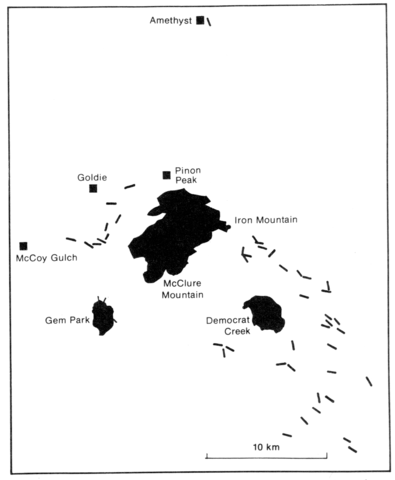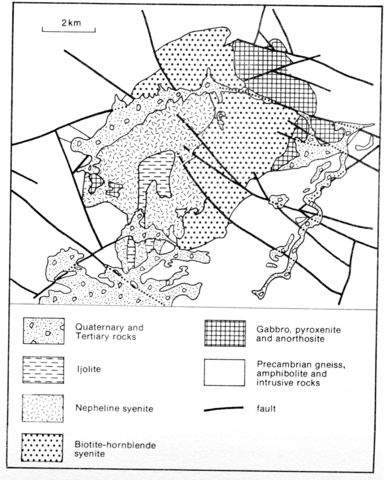stripes
This complex, located in the Wet Mountains of Colorado, has two centres; to the southwest is a complex of nepheline syenites and ijolites distributed around McClure Mountain, while in the northeast, around Iron Mountain, is a predominantly ultramafic complex of layered pyroxenites. The whole complex intrudes Proterozoic (1.6-2.5 Ma) metamorphic rocks, chiefly granitic and hornblende gneisses and amphibolites, which are fenitized in places, the whole covering 46 km2. The northeastern ultramafic complex consists of a layered, funnel-shaped intrusion consisting of gabbro, pyroxenite, dunite, anorthosite and Ti-magnetite ores which display mineralogical layering including graded bedding, cross-bedding and scour-and-fill structures (Shawe and Parker, 1967). There is no apparent cryptic variation. These rocks consist of bytownite-labradorite, clinopyroxene, Mg-rich olivine, Ti-magnetite and a little brown amphibole, biotite, green spinel and occasional aegirine as rims on pyroxene in some anorthositic rocks. The nepheline-bearing rocks centred on McClure Mountain consist of a central mafic group of ijolites consisting of variable amounts of nepheline, sodic pyroxene (about 30%), biotite (25%) and accessories, including sometimes a little K-feldspar. They are cut by more leucocratic nepheline syenites with sodic amphibole (average 10%), sodic pyroxene (4%), biotite (2. 5%), nepheline (16%) and rare sodalite. Numerous xenoliths of biotite-amphibole syenite are found near the outer contacts (Parker and Hildebrand, 1963, p.8) and fenitization occurs adjacent to syenite contacts. The McClure Mountain and Iron Mountain centres are separated by an area of biotite-amphibole syenite consisting of microperthite, brown biotite, sodic amphibole, occasional sodic pyroxene and rare nepheline (Armbrustmacher and Hedge, 1982). There are numerous and varied dykes both within and outside the complex, particularly in the northwest between the complex and the Arkansas River (Heinrich and Dahlem, 1967, Fig. 1). Dykes within the complex are predominantly leucocratic trachytes and phonolite, although a multiple carbonatite dyke at McClure Gulch within the southeastern part of the McClure Mountain complex has been described by Armbrustmacher et al. (1979). Outside the complex dykes are principally lamprophyres or carbonatites with a few trachytes, and have been discussed in some detail by Heinrich and Dahlem (1970) while Armbrustmacher (1979 and 1984a) describes the petrography, mineralogy and geochemistry of the carbonatites of the McClure Mountain-Iron Mountain, Gem Park (No. 90) and Democrat Creek (No. 91) areas. Data on REE and initial 87Sr/86Sr ratios are given by Armbrustmacher and Hedge (1982) and Armbrustmacher (1984a), who also gives numerous rock analyses. A detailed palaeomagnetic study has been made by Lynnes and Van der Voo (1984).
ARMBRUSTMACHER, T.J. 1979. Replacement and primary magmatic carbonatites from the Wet Mountains area, Fremont and Custer Counties, Colorado. Economic Geology, 74: 888-901.
ARMBRUSTMACHER, T.J. 1984a. Alkaline rock complexes in the Wet Mountains area, Custer and Fremont Counties, Colorado. Professional Paper, United States Geological Survey, 1269: 1-33.
ARMBRUSTMACHER, T.J. and HEDGE, C.E. 1982. Genetic implications of minor-elememnt and Sr-isotope geochemistry of alkaline rock complexes in the Wet Mountains area, Fremont and Custer Counties, Colorado. Contributiuons to Mineralogy and Petrology, 79: 424-35.
ARMBRUSTMACHER, T.J., BROWNFIELD, I.K. and OSMONSON, L.M. 1979. Multiple carbonatite dike at McClure Gulch, Wet Mountains Alkalic Province, Fremont County, Colorado. Mountain Geologist, 16: 37-45.
HEINRICH, E.W. and ANDERSON, R.J. 1965. Carbonatites and alkalic rocks of the Arkansas River area, Fremont County, Colorado. 2. Fetid gas from carbonatite and related rocks. American Mineralogist, 50: 1914-20.
HEINRICH, E.W. and DAHLEM, D.H. 1967. Carbonatites and alkalic rocks of the Arkansas River area, Fremont County, Colorado. 4. The Pinon Peak breccia pipes. American Mineralogist, 52: 817-31.
HEINRICH, E.W. and DAHLEM, D.H. 1970. Dikes of the McClure Mountain - Iron Mountain alkalic complex, Fremont County. Colorado, U.S.A. Bulletin Volcanologique, 33: 960-76.
LYNNES, C.S. and VAN DER VOO, R. 1984. Paleomagnetism of the Cambro-Ordovician McClure Mountain alkalic complex, Colorado. Earth and Planetary Science Letters, 71: 163-72.
OLSON, J.C., MARVIN, R.F., PARKER, R.L. and MEHNERT, H.H. 1977. Age and tectonic setting of lower Paleozoic alkalic and mafic rocks, carbonatites, and thorium veins in south-central Colorado. Journal of Research, United States Geological Survey, 5: 673-87.
PARKER, R.L. and HILDEBRAND, F.A. 1963. Preliminary report on alkalic intrusive rocks in the northern Wet Mountains, Colorado. Professional Paper, United States Geological Survey, 450-E: 8-10.
SHAWE, D.R. and PARKER, R.L. 1967. Mafic-ultramafic layered intrusion at Iron Mountain, Fremont County, Colorado. Bulletin,United States Geologucal Survey, 1251-A: 1-28


